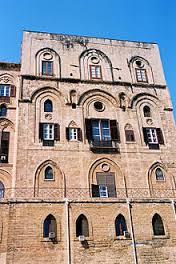Home - In and around
The King Ruggero room, which is inside the Torre Pisana, the oldest wing of the building, is characterized as the Palatine Chapel, a XII century mosaic decoration.
The mosaics decorations but in this case represent the courtly character scenes and hunting with great dedication in the performance of animals including, besides the mythological centaurs, appear leopards, peacocks, deer, swans in the background of a green area with trees and palms. The performances by the sumptuous canons but with stiffness accents, outline the clear greek-Byzantine work matrix. The ceiling of the back room instead to the period of Frederick II, as evidenced by the Swabian eagle representation. It is accessed from the hall of the winds. The refined decoration with plant and animal reveals the pictorial influence of the East Persian.
Also in the Pisana tower there are the Chinese room and the Pompeian Room, the first half of the nineteenth century, decorated with paintings by Giuseppe Patania Patricolo and John, who were the private apartments of the Marina Queen Caroline of Bourbon, who at that time lived in Palermo. And above all there is a large room of Frederick, once the throne room or the audience, now the seat of the President of the Assembly study.
The eastern facade of the Tower of Pisa is the result of a major restoration restoration Gothic Revival architect Nicholas Puglia in 1835 [8]. The same Puglia was the author of the neo-Gothic decoration project of western elevations around 1842.
On top of the Tower of Pisa is the astronomical observatory.
source wiki
TORRE PISANA AND ROOM OF KING ROGER THE NORMAN PALACE OF PALERMO
The King Ruggero room, which is inside the Torre Pisana, the oldest wing of the building, is characterized as the Palatine Chapel, a XII century mosaic decoration.
The mosaics decorations but in this case represent the courtly character scenes and hunting with great dedication in the performance of animals including, besides the mythological centaurs, appear leopards, peacocks, deer, swans in the background of a green area with trees and palms. The performances by the sumptuous canons but with stiffness accents, outline the clear greek-Byzantine work matrix. The ceiling of the back room instead to the period of Frederick II, as evidenced by the Swabian eagle representation. It is accessed from the hall of the winds. The refined decoration with plant and animal reveals the pictorial influence of the East Persian.
Also in the Pisana tower there are the Chinese room and the Pompeian Room, the first half of the nineteenth century, decorated with paintings by Giuseppe Patania Patricolo and John, who were the private apartments of the Marina Queen Caroline of Bourbon, who at that time lived in Palermo. And above all there is a large room of Frederick, once the throne room or the audience, now the seat of the President of the Assembly study.
The eastern facade of the Tower of Pisa is the result of a major restoration restoration Gothic Revival architect Nicholas Puglia in 1835 [8]. The same Puglia was the author of the neo-Gothic decoration project of western elevations around 1842.
On top of the Tower of Pisa is the astronomical observatory.
source wiki



